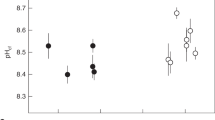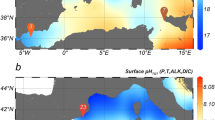Abstract
Stable oxygen and carbon isotope measurements on biogenic calcite and aragonite have become standard tools for reconstructing past oceanographic and climatic change. In aquatic organisms, 18O/16O ratios in the shell carbonate are a function of the ratio in the sea water and the calcification temperature1. In contrast, 13C/12C ratios are controlled by the ratio of dissolved inorganic carbon in sea water and physiological processes such as respiration and symbiont photosynthesis2. These geochemical proxies have been used with analyses of foraminifera shells to reconstruct global ice volumes3, surface and deep ocean temperatures4,5, ocean circulation changes6 and glacial–interglacial exchange between the terrestrial and oceanic carbon pools7. Here, we report experimental measurements on living symbiotic and non-symbiotic plankton foraminifera (Orbulina universa and Globigerina bulloides respectively) showing that the 13C/12C and 18O/16O ratios of the calcite shells decrease with increasing seawater [CO32−]. Because glacial-period oceans had higher pH and [CO32−] than today8, these new relationships confound the standard interpretation of glacial foraminiferal stable-isotope data. In particular, the hypothesis that the glacial–interglacial shift in the 13C/12C ratio was due to a transfer of terrestrial carbon into the ocean7 can be explained alternatively by an increase in ocean alkalinity25. A carbonate-concentration effect could also help explain some of the extreme stable-isotope variations during the Proterozoic and Phanerozoic aeons9.
This is a preview of subscription content, access via your institution
Access options
Subscribe to this journal
Receive 51 print issues and online access
$199.00 per year
only $3.90 per issue
Buy this article
- Purchase on Springer Link
- Instant access to full article PDF
Prices may be subject to local taxes which are calculated during checkout




Similar content being viewed by others
References
Epstein, S., Buchsbaum, R., Lowenstam, H. A. & Urey, H. C. Revised carbonate-water isotopic temperature scale. Geol. Soc. Am. Bull. 64, 1315–1325 (1953).
Spero, H. J., Lerche, I. & Williams, D. F. Opening the carbon isotope “vital effect” black box, 2: Quantitative model for interpreting foraminiferal carbon isotope data. Paleoceanography 6, 639–655 (1991).
Shackleton, N. J. & Opdyke, N. D. Oxygen isotope and palaeomagnetic stratigraphy of equatorial Pacific core V28-238: Oxygen isotope temperatures and ice volumes on a 105 year and 106 year scale. Quat. Res. 3, 39–55 (1973).
Broecker, W. S. Oxygen isotope constraints on surface ocean temperatures. Quat. Res. 26, 121–134 (1986).
Labeyrie, L. D., Duplessy, J.-C. & Blanc, P. L. Variations in mode of formation and temperature of oceanic deep waters over the past 125,000 years. Nature 327, 477–482 (1987).
Duplessy, J. C. et al. Deepwater source variations during the last climatic cycle and their impact on the global deepwater circulation. Paleoceanography 3, 343–360 (1988).
Shackleton, N. J. Carbon-13 in Uvigerina: tropical rainsforest history and the equatorial Pacific carbonate dissolution cycles.in The Fate of Fossil Fuel CO2in the Oceans (eds Andersen, N. R. & Malahoff, A.) 401–427 (Plenum, New York, (1977)).
Sanyal, A., Hemming, N. G., Hanson, G. N. & Broecker, W. S. Evidence for a higher pH in the glacial ocean from boron isotopes in foraminifera. Nature 373, 234–236 (1995).
Kaufman, A. J., Jacobsen, S. B. & Knoll, A. H. The Vendian record of Sr and C isotopic variations in seawater: Implications for tectonics and paleoclimate. Earth Planet. Sci. Lett. 120, 409–430 (1993).
Fairbanks, R. G., Sverdlove, M., Free, R., Wiebe, P. H. & Be, A. W. H. Vertical distribution and isotopic fractionation of living planktonic foraminifera from the Panama Basin. Nature 298, 841–844 (1982).
Spero, H. J. & Lea, D. W. Experimental determination of stable isotope variability in Globigerina bulloides : Implications for paleoceanographic reconstruction. Mar. Micropaleontol. 28, 231–246 (1996).
McConnaughey, T. 13C and 18O isotopic disequilibrium in biological carbonates: II. In vitro simulation of kinetic isotope effects. Geochim. Cosmochim. Acta 53, 163–171 (1989).
Spero, H. J. & Parker, S. L. Photosynthesis in the symbiotic planktonic foraminifer Orbulina universa, and its potential contribution to oceanic primary productivity. J. Foram. Res. 15, 273–281 (1985).
Spero, H. J. Do planktic foraminifera accurately record shifts in the carbon isotopic composition of sea water Σ;CO2? Mar. Micropaleontol. 19, 275–285 (1992).
McConnaughey, T. 13C and 18O isotopic disequilibrium in biological carbonates: I. Patterns. Geochim. Cosmochim. Acta 53, 151–162 (1989).
Smith, J. E., Risk, M. J., Schwarcz, H. P. & McConnaugheyy, T. A. Rapid climate change in the North Atlantic during the Younger Dryas recorded by deep-sea corals. Nature 386, 818–820 (1997).
Spero, H. J. & Lea, D. W. Intraspecific stable isotope variability in the planktic foraminifera Globigerinoides sacculifer : Results from laboratory experiments. Mar. Micropaleontol. 22, 221–234 (1993).
McCrea, J. M. On the isotopic chemistry of carbonates and a paleotemperature scale. J. Chem. Phys. 18, 849–857 (1950).
Zhang, J., Quay, P. D. & Wilbur, D. O. Carbon isotope fractionation during gas–water exchange and dissolution of CO2. Geochim. Cosmochim. Acta 59, 107–114 (1995).
Usdowski, E. & Hoefs, J. Oxygen isotope exchange between carbonic acid, bicarbonate, carbonate, and water: A re-examination of the data of McCrea (1950) and an expression for the overall partitioning of oxygen isotopes between the carbonate species and water. Geochim. Cosmochim. Acta 57, 3815–3818 (1993).
McConnaughey, T. A., Burdett, J., Whelan, J. F. & Paull, C. K. Carbon isotopes in biological carbonates: Respiration and photosynthesis. Geochim. Cosmochim. Acta 61, 611–622 (1997).
ter Kuile, B., Erez, J. & Padan, E. Mechanisms for the uptake of inorganic carbon by two species of symbiont-bearing foraminifera. Mar. Biol. 103, 241–251 (1989).
Barnola, J. M., Raynaud, D., Korotkevich, Y. S. & Lorius, C. Vostock ice core provides 160,000-year record of atmospheric CO2. Nature 329, 408–413 (1987).
Broecker, W. S. & Peng, T.-H. What caused the glacial to interglacial CO2change?in The Global Carbon Cycle (ed. Heimann, M.) 95–115 (Springer, Berlin, (1993)).
Lea, D. W., Spero, H. J., Bijma, J. & Archer, D. Implications of a carbonate ion effect on shell carbon and oxygen isotopes for glacial ocean conditions. EOS 77 (46) Fall Meeting Suppl. F334((1996)).
Shackleton, N. J., Hall, M. A., Line, J. & Shuxi, C. Carbon isotope data in core V19-30 confirm reduced carbon dioxide concentration in the ice age atmosphere. Nature 306, 319–322 (1983).
Shackleton, N. J., Le, J., Mix, A. & Hall, M. A. Carbon isotope records from Pacific surface waters and atmospheric carbon dioxide. Quat. Sci. Rev. 11, 387–400 (1992).
Crowley, T. J. Ice age terrestrial carbon changes revisited. Global Biogeochem. Cycles 9, 377–389 (1995).
Guilderson, T. P., Fairbanks, R. G. & Rubenstone, J. L. Tropical temperature variations since 20,000 years ago: Modulating interhemispheric climate change. Science 263, 663–665 (1994).
Thompson, L. G. et al. Late glacial stage and Holocene tropical ice core records from Huascaran, Peru. Science 269, 46–50 (1995).
Berner, R. A. Geocarb II: A revised model of atmospheric CO2over Phanerozoic time. Am. J. Sci. 294, 56–91 (1994).
Grotzinger, J. P. & Kasting, J. F. New constraints on Precambrian ocean composition. J. Geol. 101, 235–243 (1993).
Wadleigh, M. A. & Veizer, J. 18O/16O and 13C/12C in Lower Paleozoic articulate brachiopods: Implications for the isotopic composition of seawater. Geochim. Cosmochim. Acta 56, 431–443 (1992).
Acknowledgements
We thank the staff of the Wrigley Institute of Environmental Science and E. Kincaid, C. Hamilton, J. Dailey, E. Komsky, T. Mashiotta, M. Uhle, A. Sanyal, D. Chan, E. Mochon and M. Cramer for their help in the field. Thanks also to A. Russell and D. Sumner for comments on the manuscript. This research was supported by the US National Science Foundation (H.J.S. and D.W.L.) and by SFB 261 and the Program for the Advancement of Special Research Projects at the Alfred Wegener Institute, Germany (J.B.).
Author information
Authors and Affiliations
Corresponding author
Rights and permissions
About this article
Cite this article
Spero, H., Bijma, J., Lea, D. et al. Effect of seawater carbonate concentration on foraminiferal carbon and oxygen isotopes. Nature 390, 497–500 (1997). https://doi.org/10.1038/37333
Received:
Accepted:
Issue Date:
DOI: https://doi.org/10.1038/37333
This article is cited by
-
Anthropogenic acidification of surface waters drives decreased biogenic calcification in the Mediterranean Sea
Communications Earth & Environment (2023)
-
Warm deep-sea temperatures across Eocene Thermal Maximum 2 from clumped isotope thermometry
Communications Earth & Environment (2022)
-
Thresholds of temperature change for mass extinctions
Nature Communications (2021)
-
Geographical differences in the stable isotope ratios of Pacific saury in the North Pacific Ocean
Fisheries Science (2021)
-
Decadal variability in twentieth-century ocean acidification in the California Current Ecosystem
Nature Geoscience (2020)
Comments
By submitting a comment you agree to abide by our Terms and Community Guidelines. If you find something abusive or that does not comply with our terms or guidelines please flag it as inappropriate.



